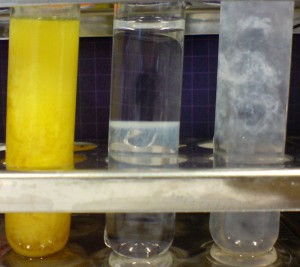Playlist
Show Playlist
Hide Playlist
Balancing Redox Reactions – Other Ionic Reactions
-
Slides 02 Chemistry Advanced Le Gresley.pdf
-
Download Lecture Overview
00:02 Balancing RedOx reactions. At the first glance, the equation representing the equation of zinc metal with silver ions and might appear to be balanced. Why not? We have zinc on one side, we have zinc on the other. We have silver on one side, we have silver on the other. But, note, the number of electrons, in this particular case, is not being made consistent. We have a positive charge on one side, but we have two positive charges on the other. This cannot be acceptable. So, a balanced equation must also have charge balance as well as mass balance. As mentioned before, we can split the reaction into two half reactions. So, let’s do that. We will balance the RedOx reaction using the oxidation number method. So, we’ve see the previous equation and now, it’s up to you to try and balance it. The way in which we balance it is first, by assigning oxidation number to all elements in the reaction, bearing in mind that in the case of zinc, we have a 2+ oxidation state and silver, we can only have a 1+ oxidation state. Identify the species that are being oxidised or reduced and then compute the number of electrons lost in the oxidation process and gained in the reduction process, where necessary drawing lines between the two pairs including the number of electrons which have been lost and the number of electrons being gained. What we then do is multiply one or both reactions so that both numbers match, using these factors as balancing coefficients. And finally, balance any other species that were not involved directly in that electron exchange to ensure that we have the correct numbers of each component on either side of the reaction. 01:43 Now, let’s bring on to quantitative analysis. Analytical chemistry, which is again one part of this, deals with the determination of the composition of materials, that is the analysis of materials. What I’d like to draw your attention to is gravimetric analysis. 02:03 Gravimetric analysis is a type of quantitative analysis in which the amount of species in the material is determined by converting the species into a product that can be isolated and weighed. There are many, many different types of analytical methodology that are used, not just in terms of inorganic chemistry, but also in terms of organic chemistry. But, that is really beyond our terms of reference for this. Instead, in the context of... context of molarity, I’d like us to discuss here how you can determine the amount of something which is in solution by precipitating it out and then weighing it. Precipitation reactions are often used in gravimetric analysis and the precipitate from the reactions can then be filtered, dried and weighed. Consider for a moment the problem of determining the amount of lead in a sample of drinking water. If you add sodium sulphate to a sample of soluble lead, maybe it’s a lead nitrate or some such, it will precipitate out insoluble lead sulphate as per the reaction here. Indeed, many lead compounds, lead sulphate, lead chlorides and oxides are not particularly soluble in water and therefore, it is a useful reaction to carry out when trying to precipitate out those relatively insoluble transition metal ions. Sodium sulphate, shown here as Na2SO4, plus iron gives sodium and iron and lead sulphate. Lead sulphate can then be filtered, dried and weighed. It’s also important to bear in mind, and I go back to what I was saying in the previous module, the Pb, you may think, doesn’t have any correlation to lead. It’s actually derived from the Latin, Plumbum. Hence, the name Pb as the chemical symbol for lead.
About the Lecture
The lecture Balancing Redox Reactions – Other Ionic Reactions by Adam Le Gresley, PhD is from the course Ionic Chemistry.
Included Quiz Questions
Which of the following is true of a balanced redox reaction equation?
- The charges and masses are balanced on both sides of the equation.
- Only charges are balanced, whereas masses can vary.
- Only masses are balanced, whereas charges can vary.
- Both charges and masses can vary.
- The number of electrons gained can never be equal to the number of electrons lost during a redox reaction.
Gravimetric analysis deals with which of the following?
- Quantitative analysis of the amount of a species in a material
- Energetics of chemical reactions
- Photochemical reactions
- Thermal changes in materials
- Nuclear applications of a newly discovered element
The formation of a white insoluble precipitate of lead sulfate when sodium sulfate is added to drinking water indicates which of the following?
- Lead contamination in the drinking water
- Silver contamination in the drinking water
- Copper pollution in the drinking water
- Iron contamination in the drinking water
- Zinc contamination in the drinking water
Customer reviews
5,0 of 5 stars
| 5 Stars |
|
5 |
| 4 Stars |
|
0 |
| 3 Stars |
|
0 |
| 2 Stars |
|
0 |
| 1 Star |
|
0 |




